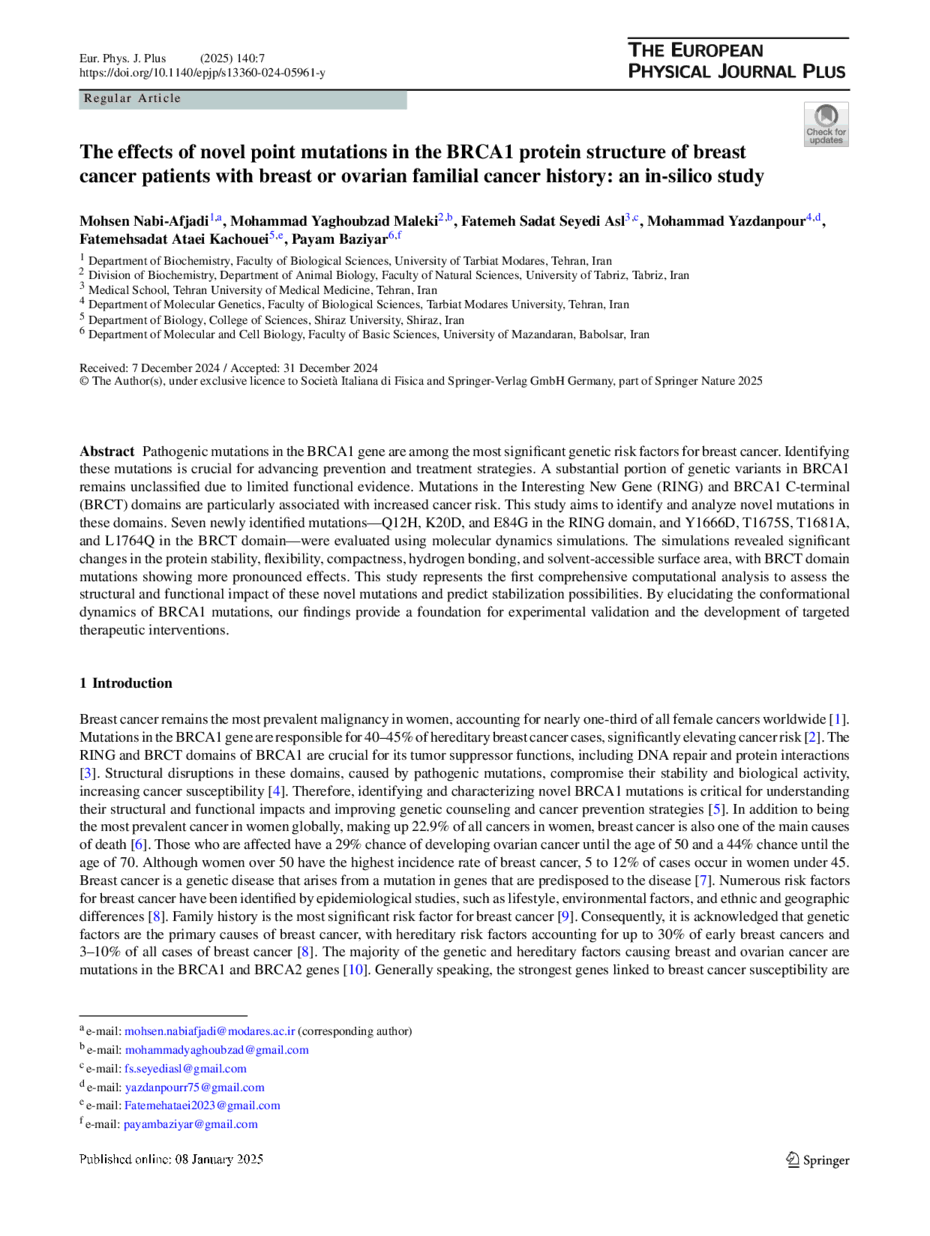https://doi.org/10.1140/epjp/s13360-024-05961-y
Regular Article
The effects of novel point mutations in the BRCA1 protein structure of breast cancer patients with breast or ovarian familial cancer history: an in-silico study
1
Department of Biochemistry, Faculty of Biological Sciences, University of Tarbiat Modares, Tehran, Iran
2
Division of Biochemistry, Department of Animal Biology, Faculty of Natural Sciences, University of Tabriz, Tabriz, Iran
3
Medical School, Tehran University of Medical Medicine, Tehran, Iran
4
Department of Molecular Genetics, Faculty of Biological Sciences, Tarbiat Modares University, Tehran, Iran
5
Department of Biology, College of Sciences, Shiraz University, Shiraz, Iran
6
Department of Molecular and Cell Biology, Faculty of Basic Sciences, University of Mazandaran, Babolsar, Iran
a
mohsen.nabiafjadi@modares.ac.ir
Received:
7
December
2024
Accepted:
31
December
2024
Published online:
8
January
2025
Pathogenic mutations in the BRCA1 gene are among the most significant genetic risk factors for breast cancer. Identifying these mutations is crucial for advancing prevention and treatment strategies. A substantial portion of genetic variants in BRCA1 remains unclassified due to limited functional evidence. Mutations in the Interesting New Gene (RING) and BRCA1 C-terminal (BRCT) domains are particularly associated with increased cancer risk. This study aims to identify and analyze novel mutations in these domains. Seven newly identified mutations—Q12H, K20D, and E84G in the RING domain, and Y1666D, T1675S, T1681A, and L1764Q in the BRCT domain—were evaluated using molecular dynamics simulations. The simulations revealed significant changes in the protein stability, flexibility, compactness, hydrogen bonding, and solvent-accessible surface area, with BRCT domain mutations showing more pronounced effects. This study represents the first comprehensive computational analysis to assess the structural and functional impact of these novel mutations and predict stabilization possibilities. By elucidating the conformational dynamics of BRCA1 mutations, our findings provide a foundation for experimental validation and the development of targeted therapeutic interventions.
Copyright comment Springer Nature or its licensor (e.g. a society or other partner) holds exclusive rights to this article under a publishing agreement with the author(s) or other rightsholder(s); author self-archiving of the accepted manuscript version of this article is solely governed by the terms of such publishing agreement and applicable law.
© The Author(s), under exclusive licence to Società Italiana di Fisica and Springer-Verlag GmbH Germany, part of Springer Nature 2025
Springer Nature or its licensor (e.g. a society or other partner) holds exclusive rights to this article under a publishing agreement with the author(s) or other rightsholder(s); author self-archiving of the accepted manuscript version of this article is solely governed by the terms of such publishing agreement and applicable law.





